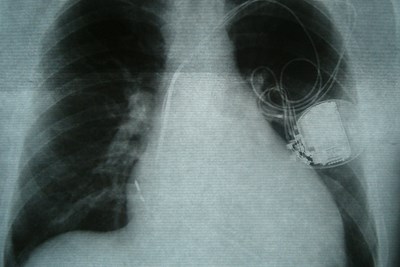In 1958, Wilson Greatbatch was attempting to invent a device intended to record heart rhythms when he put a wrong piece in his machine. Instead of recording, it actually sent out electrical pulses, which Greatbatch had the presence of mind to realize was almost exactly like how the heart is induced to beat.
By April of 1960, the pacemaker—a work in progress since the late 1800s—could last up to a year and a half and was ready for human implantation. Since then, the pacemaker has made leaps and bounds and changed millions of lives. Here’s a look at exactly what a pacemaker is and how it works.
How the Heart Works
Every day, the average heart beats over 100,000 times, sending oxygen-rich blood through the arteries to extremities, organs, and even the brain. The four chambers of the heart (the two upper atria and the two lower ventricles) work in tandem to send and receive blood. Each heartbeat is triggered by the sinoatrial (SA) node, a group of cells in the right atria that work as a natural pacemaker when they’re functioning properly.
The SA node sends out an electrical signal that induces the atrium to squeeze, which sends blood into the ventricles. The atrioventricular (AV) node briefly delays the SA node’s signal from reaching the ventricles so that they contract secondarily. Once the ventricles contract, oxygen-rich blood is sent out through the arteries, all over the body, and eventually back around to be sent out again.
Why Pacemakers Are Used
Pacemakers are used to ease arrhythmias—various conditions in which the heart fails to maintain its natural, healthy rhythm. In tachycardia, the heart beats too quickly; bradycardia is a condition in which it beats much too slowly. Although a human resting pulse may be anywhere from 40 to 100 beats a minute, when an arrhythmia is not present, your pulse generally stays about the same when you're at rest.
Pacemakers are used to address these irregular rhythms and attempt to normalize them.
What Pacemakers Do
Pacemakers can be implanted temporarily in emergency situations (like a heart attack or too much medication) or permanently in patients with chronic heart conditions. Pacemakers may use demand or rate-responsive pacing. Demand pacing only changes the heart rate when it senses something is amiss; rate-responsive pacing recognizes activity level based on bodily clues and adjusts the heart rate accordingly.
The electrical signal emitted by the pacemaker overrides the SA node’s signal, allowing the heart to beat at a steady and constant rate. According to the National Institute of Health’s National Heart, Lung, and Blood Institute, “a pacemaker consists of a battery, a computerized generator, and wires with sensors [electrodes] at their tips,” that connect to the heart.
Pacemakers not only keep heartbeats regular, but also provide constant monitoring by picking up the heart’s electrical signals. This information is sent to the generator, which then figures out the appropriate signal to send to the heart to override the SA node’s signal. All of this activity is recorded for your doctor to look at, so that your pacemaker can be adjusted to best suit your body.



